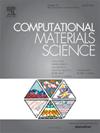Revealing Photo-electrochemical, Piezoelectric, and Ferroelectric Properties of γ-SnTe Monolayer via Density Functional Theory
IF 3.1
3区 材料科学
Q2 MATERIALS SCIENCE, MULTIDISCIPLINARY
引用次数: 0
Abstract
In this work, Density Functional Theory (DFT) calculations were performed to explore the photo-electrochemical, piezoelectric, and ferroelectric properties of the γ-SnTe monolayer. The optimized structure is confirmed to be dynamically and mechanically stable, exhibiting isotropic elastic behavior with an elastic modulus of 18.92 N/m and a shear modulus of 7.56 N/m. Electronic band structure analysis reveals that the γ-SnTe monolayer is an indirect semiconductor with a band gap of 2.56 eV, and the separation between charge carriers is clearly observed, with an effective mass mobility of approximately 0.44 m0. Under biaxial strain, the band states continuously shift, optimizing redox potentials for surface chemical reactions. The material also demonstrates high piezoelectric coefficients, enabling efficient conversion of mechanical energy into electrical energy. Additionally, ferroelectricity is confirmed with a residual polarization of Pz = 5 pC/m and a low-energy switching barrier, making γ-SnTe highly suitable for low-power memory devices. These findings establish the γ-SnTe monolayer as a promising multifunctional material with potential applications in green energy technologies, electromechanical systems, and next-generation memory devices.

利用密度泛函理论揭示γ-SnTe单层的光电化学、压电和铁电性质
在这项工作中,密度泛函理论(DFT)计算进行了探索的光电电化学,压电和铁电性质的γ-SnTe单层。优化后的结构具有动态和机械稳定性,弹性模量为18.92 N/m,剪切模量为7.56 N/m,具有各向同性弹性行为。电子能带结构分析表明,γ-SnTe单层为间接半导体,带隙为2.56 eV,载流子间分离明显,有效质量迁移率约为0.44 m0。在双轴应变作用下,带态不断变化,优化了表面化学反应的氧化还原电位。该材料还显示出高压电系数,能够有效地将机械能转换为电能。此外,γ-SnTe的残余极化为Pz = 5 pC/m,并且具有低能量的开关势垒,这使得γ-SnTe非常适合用于低功耗存储器件。这些发现表明,γ-SnTe单层材料是一种很有前途的多功能材料,在绿色能源技术、机电系统和下一代存储器件中具有潜在的应用前景。
本文章由计算机程序翻译,如有差异,请以英文原文为准。
求助全文
约1分钟内获得全文
求助全文
来源期刊

Computational Materials Science
工程技术-材料科学:综合
CiteScore
6.50
自引率
6.10%
发文量
665
审稿时长
26 days
期刊介绍:
The goal of Computational Materials Science is to report on results that provide new or unique insights into, or significantly expand our understanding of, the properties of materials or phenomena associated with their design, synthesis, processing, characterization, and utilization. To be relevant to the journal, the results should be applied or applicable to specific material systems that are discussed within the submission.
 求助内容:
求助内容: 应助结果提醒方式:
应助结果提醒方式:


